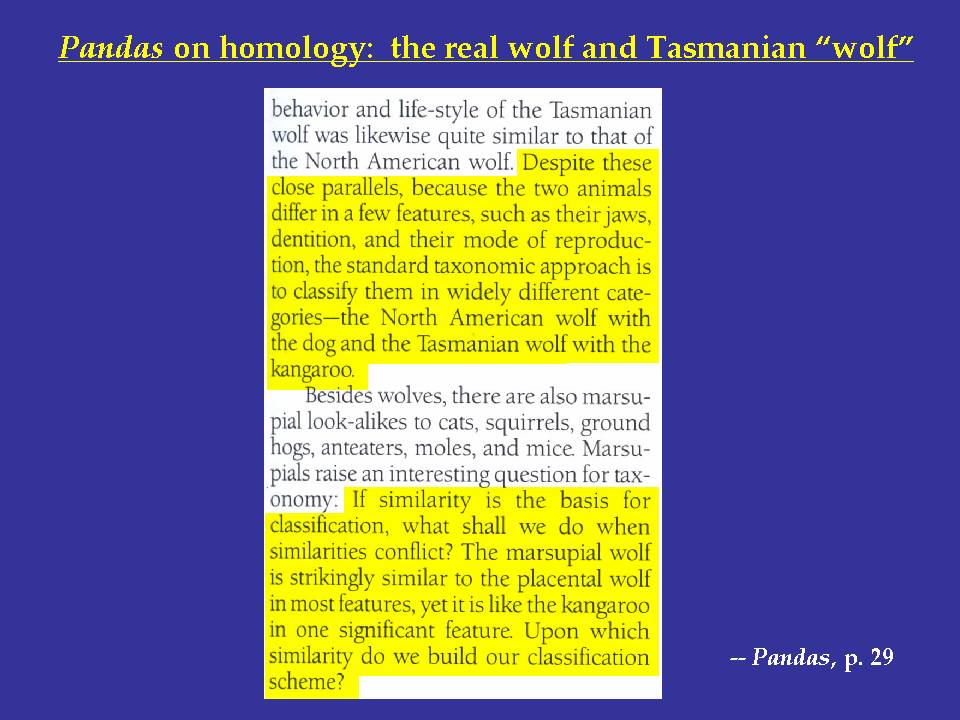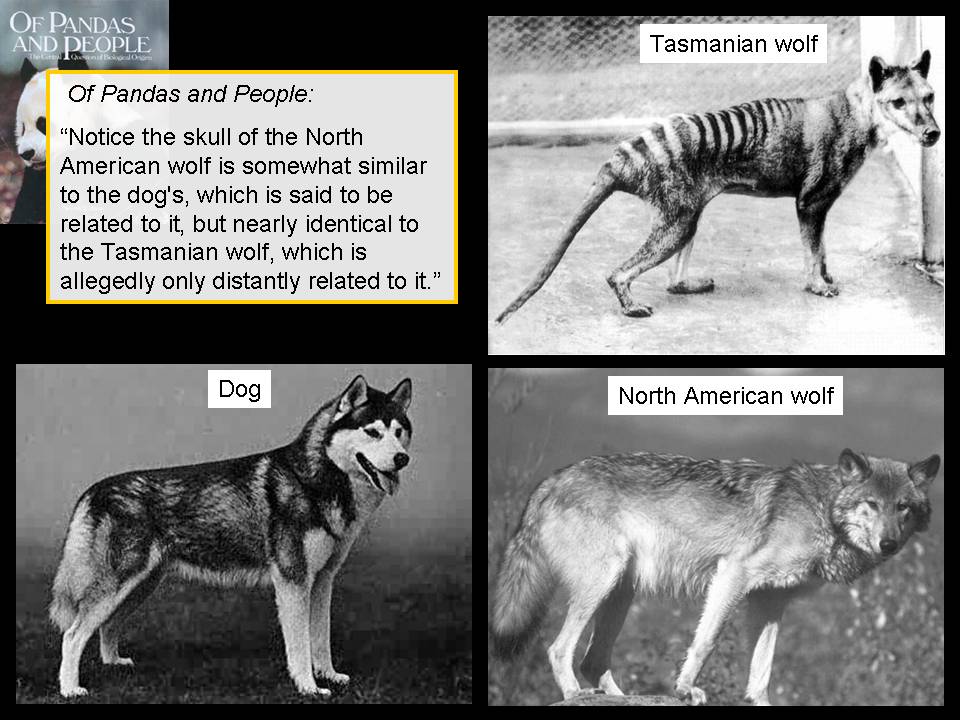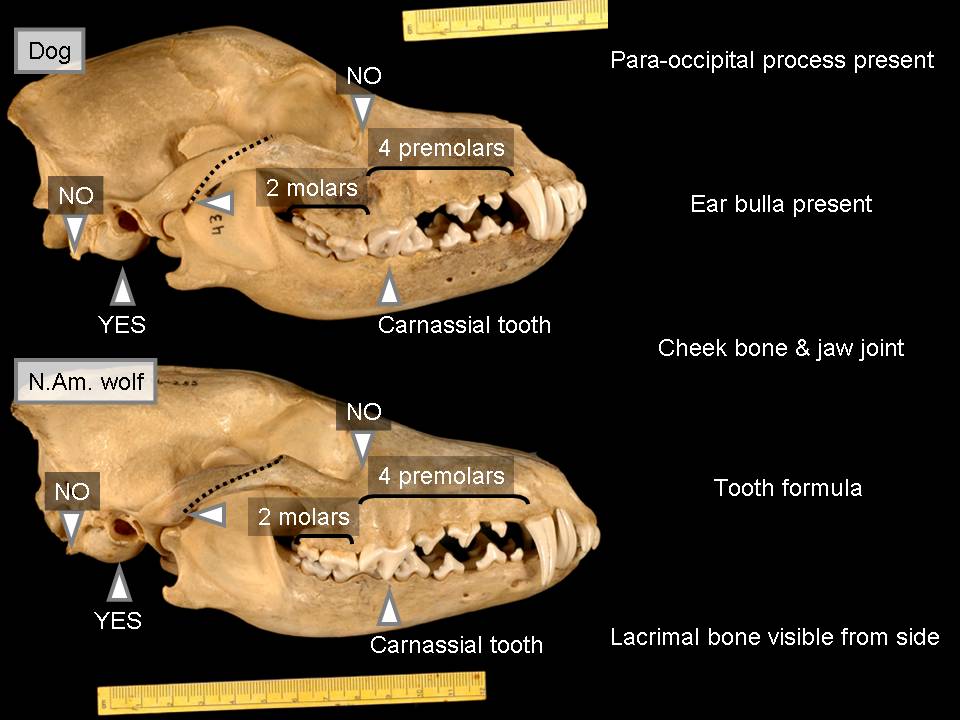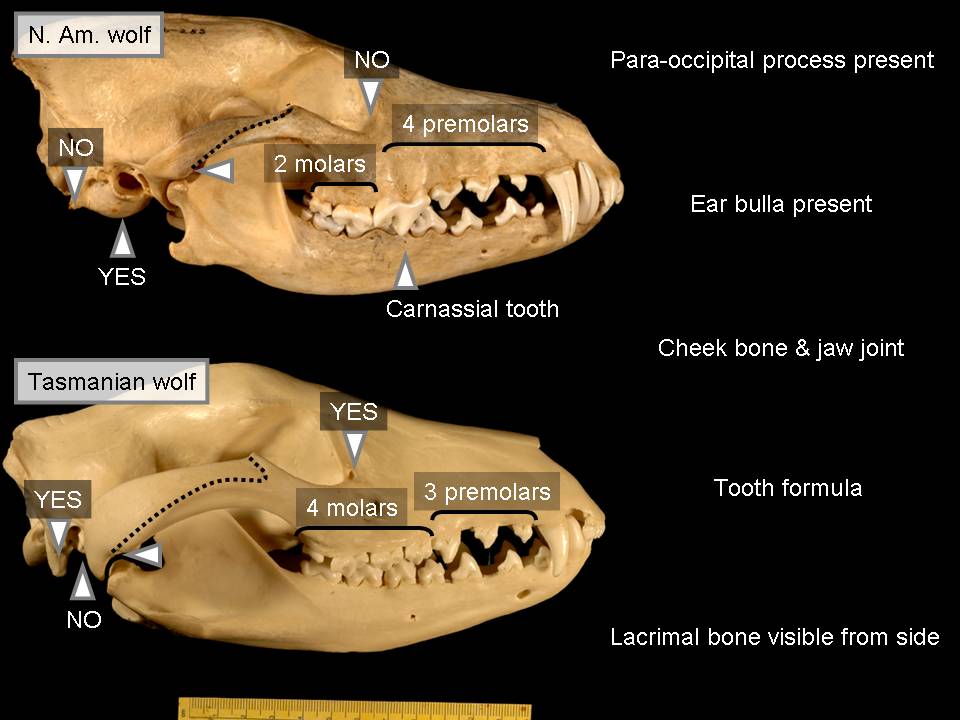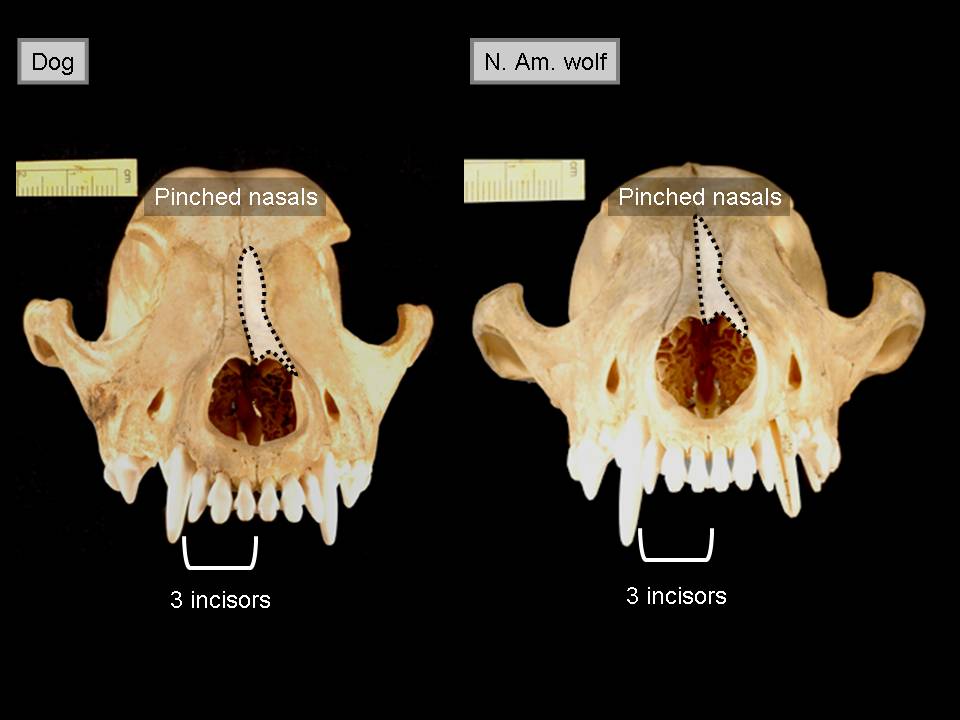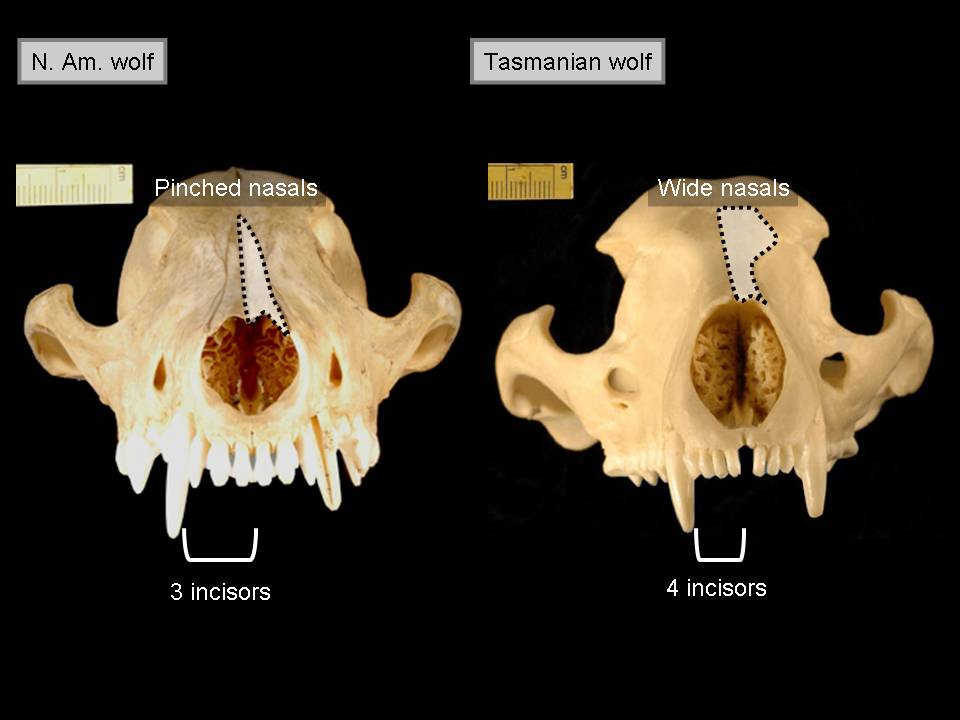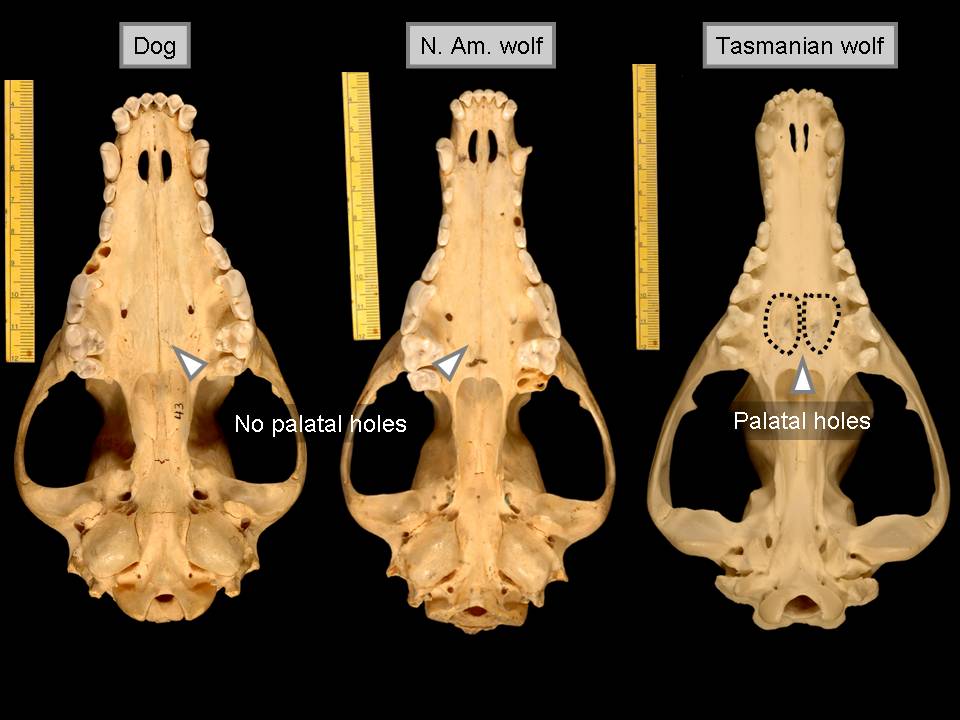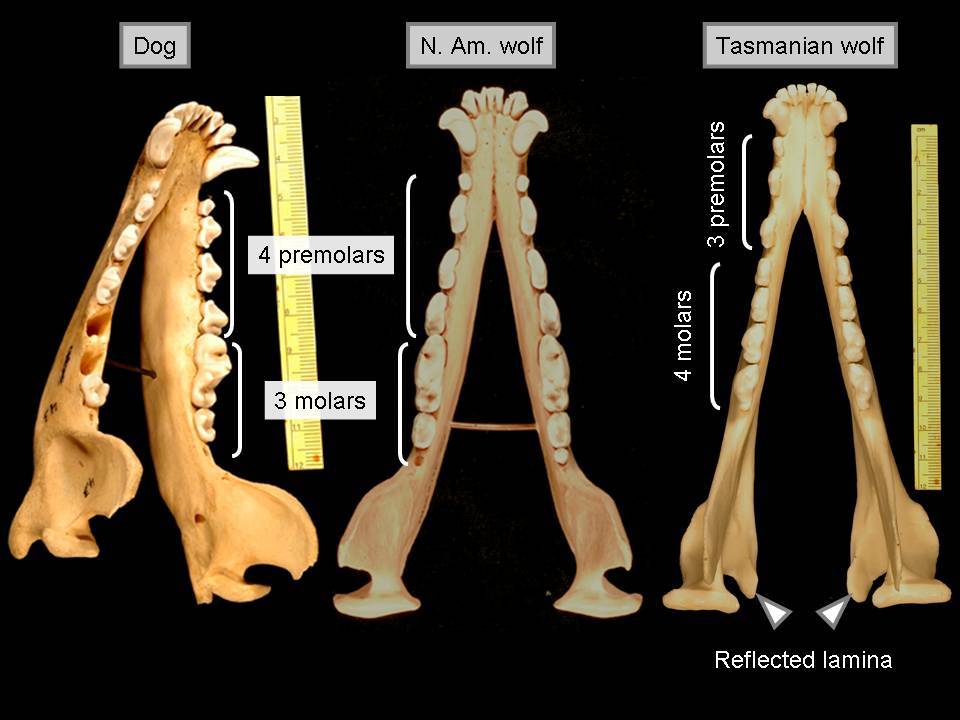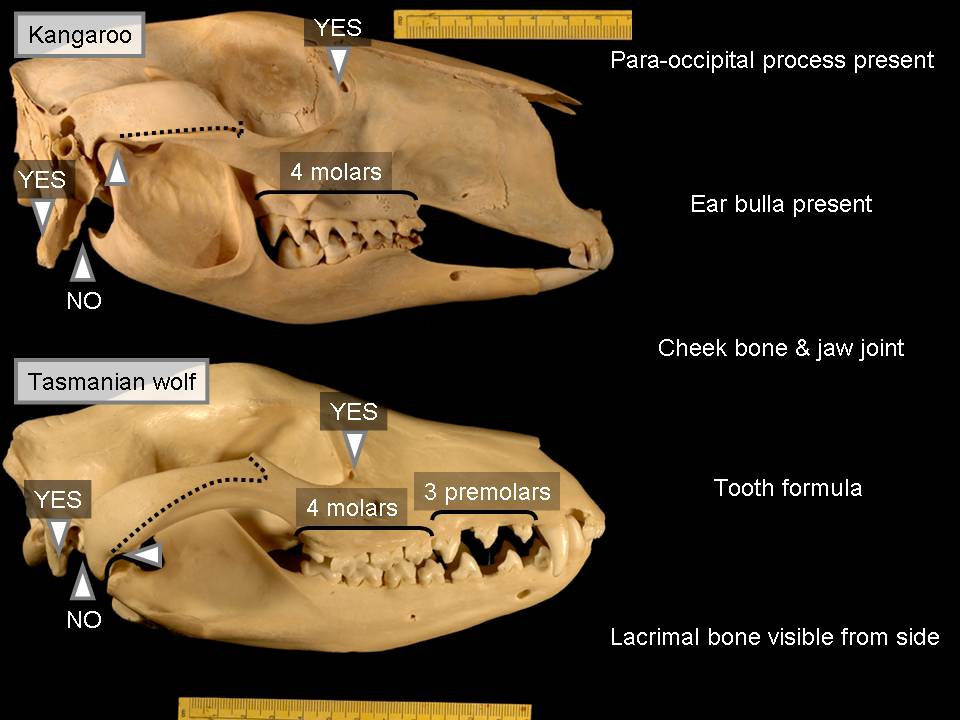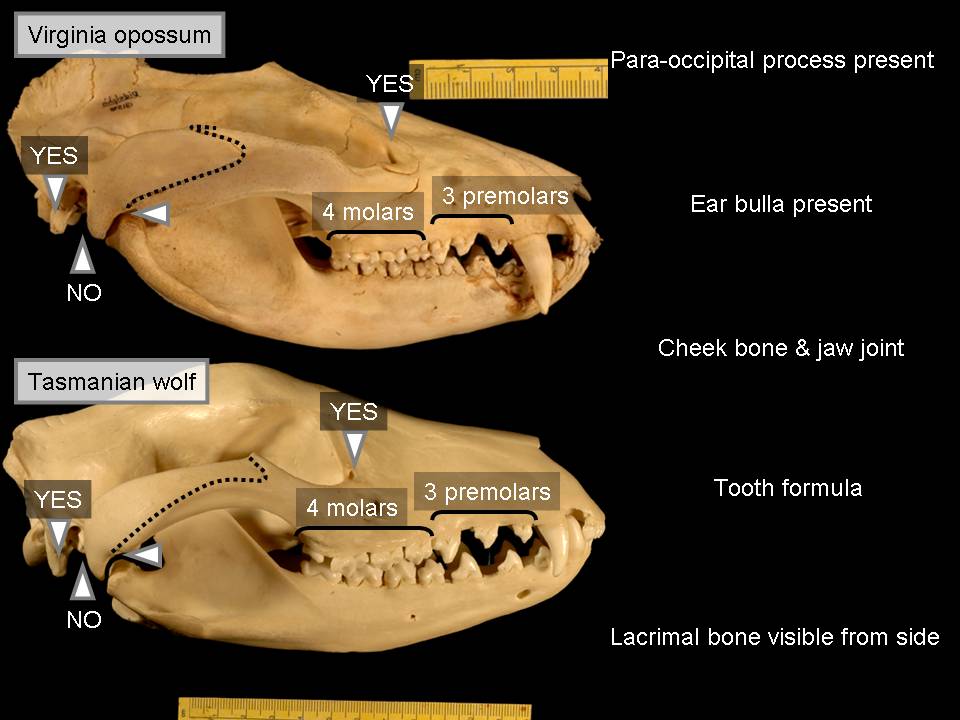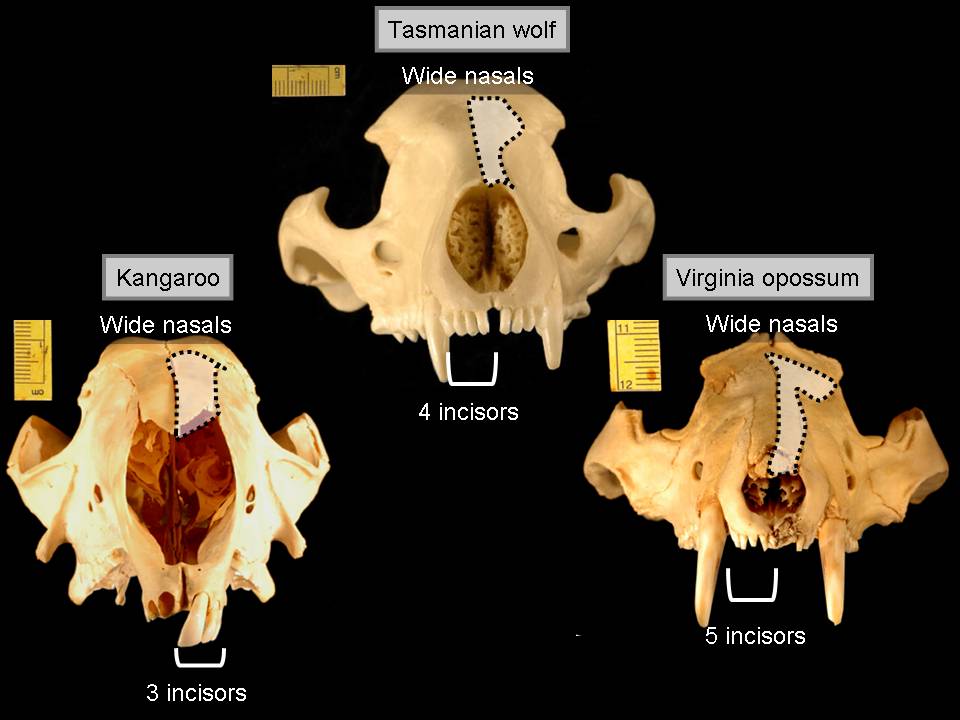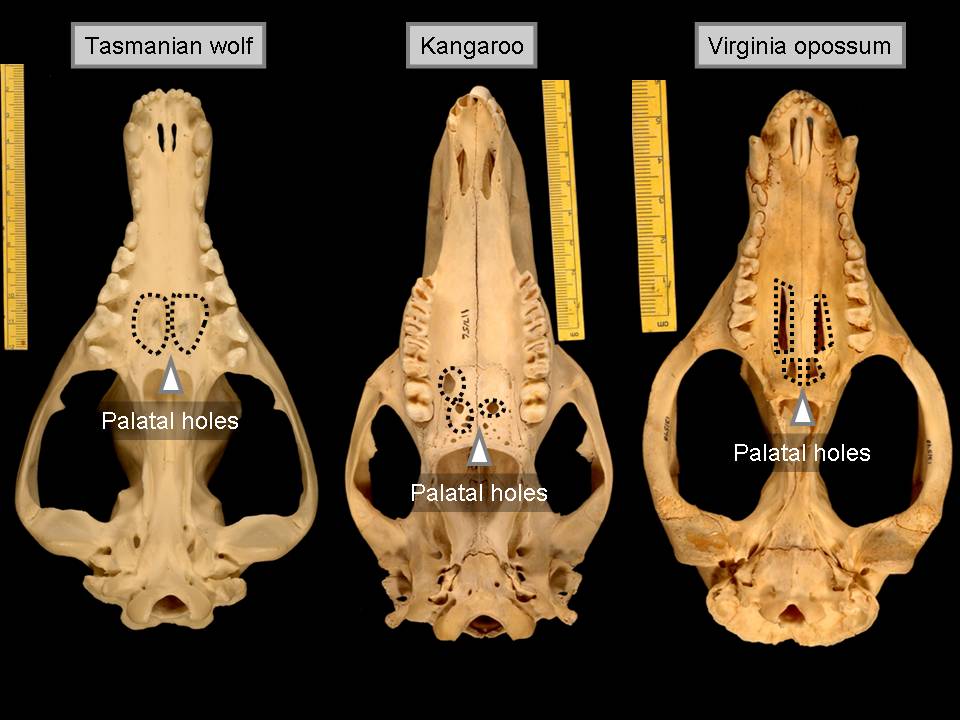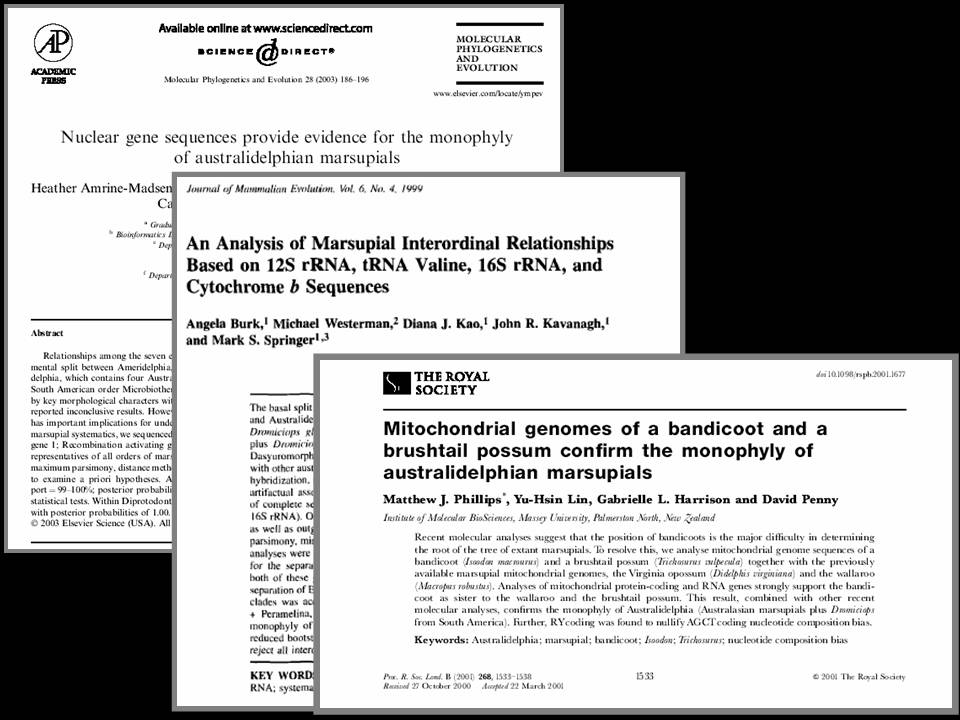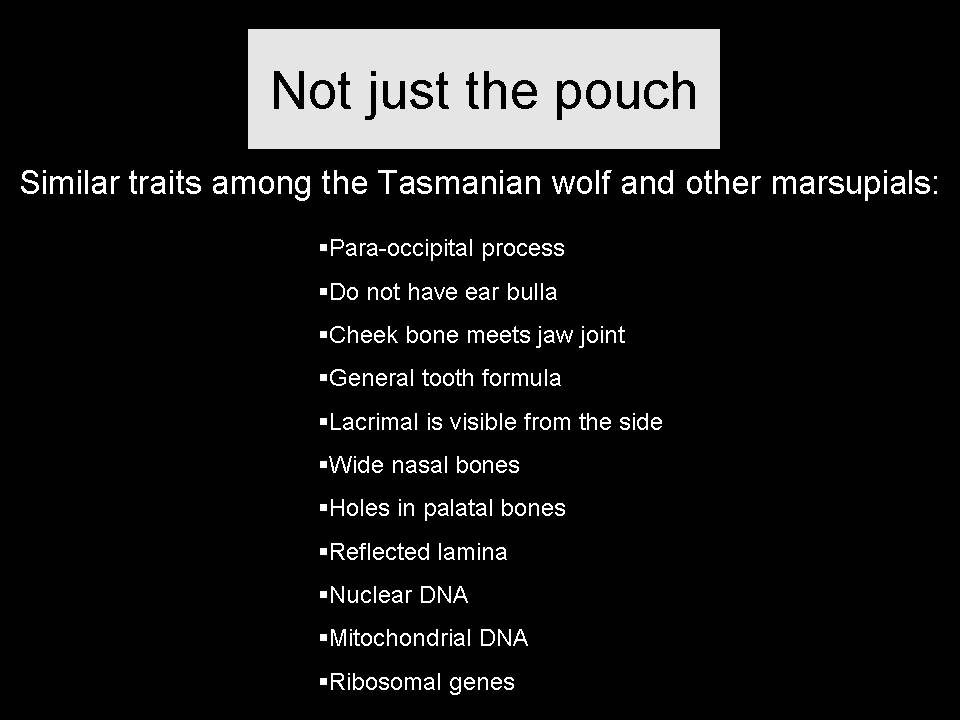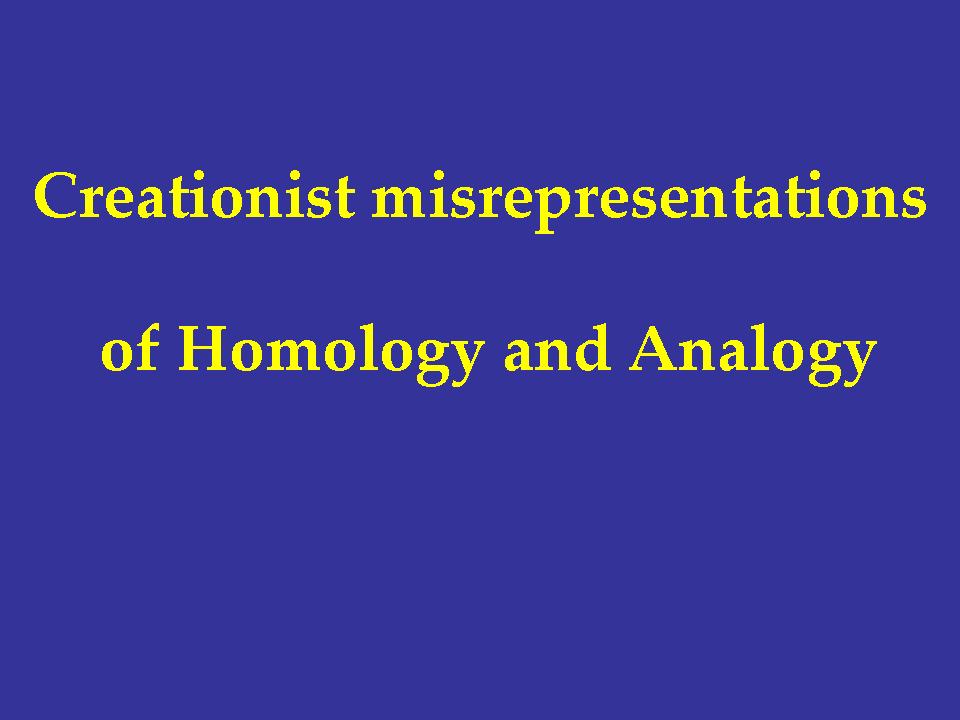 |
| Slide 83: In the final section, Padian turns to homology and analogy, fundamental concepts in comparative biology. Chapter 5 of Pandas attempts to overturn the idea that homology is strong evidence for common ancestry. |
| (Right-click to download pdf.) |
Creationist misrepresentations of Homology and Analogy
Q. What's homology? Last concept, Your Honor.
A. Homology is the central concept of comparative biology. It's the idea that allows you to compare structures in different animals, the kinds of structures that enable you to say that the bone you have here that we call a humerus is a humerus in a human, it's a humerus in a bat or a goat or a bird or a frog, and this is a very old concept. The notion of homology, the ability to compare comparable parts among organisms, goes back to the 1700's. Goethe was one of the first people who developed this concept in vertebrates as well as in plants because he was besides being the author of Faust and a great poet he was also a great morphologist.
He worked on plants and animals and was a great contributor to these ideas of morphology. Goethe, many of the other German scholars who worked with him, some of French scholars in days, and many of the scholars in Britain at this same time, contributed to this, including notably Sir Richard Owen, who was a little bit older than Darwin but really contemporary with him, but a complete anti-Darwinist in the sense of not accepting natural selection and not accepting the possibility of change from one species to the others in ways that Darwin and the evolutionists proposed.
What is so interesting about the presentation of homology by intelligent design advocates as with creation science, scientists and so on, is that they take a concept that isn't even evolutionary and they manage to completely destroy the fundamental basis on which it's built. Let's go back to the thinking of Richard Owen. In 1846 and 1848 a man who is Darwin's bitterest enemy, he is the only man that Darwin was ever said to have hated, so he's not exactly a big fan, these guys do not form a mutual admiration society, but Owen is a cosmic morphologist, he's the greatest paleontologist and comparative anatomist of his generation, and Owen said look, we have to be able to compare structures, and we can do it on a number of different criteria.
And he's not talking about evolution as saying look, this bone is a humerus because it connects to the same bones in all the animals we're looking at. Connects to the shoulder joint on the one hand, on the one arm, and it connects to the forearm bones on the other side, and that's the way we find it and that's how we can tell that this is a humerus, and this is the same in a goat.
So it's in the same position, that's the first thing. The second thing is it's made of the same stuff, it's bone, and this bone -- so it's not muscle or it's not glass, it's not anything else. It's made from the same stuff, and that's another way you can tell it's the same thing. Another criterion he used is that it develops in the same way. So for example it develops along the arm primordium and it's first beginning to be formed in cartilage and the cartilage is largely replaced by bone as the bone develops in its place.
So you have criteria of position, of what it's made of, and how it develops, and these are only a few of the criteria that people use. This is before people talk about evolution in connection to homology. Now, what Darwin did by publishing The Origin of Species, many more people accepted that organisms had common ancestors, that common ancestry explained the diversity of life. And now homology had a second dimension to it. That is that homology, the resemblances that Owen had talked about and many other morphologists had talked about, why were they similar? Because they were inherited from common ancestors. So common ancestry is not the rationale for homology. It's an explanation of the similarities that we see that is, that were actually established in pre-Darwinian terms by most classical scholars that we have.
Q. And so homology is a very well established concept within biology?
A. Yeah, and when I started by talking about how we classify things, how we make up these cladograms, we have to make sure that we're using homologous features, this is features that actually be compared and not just random features that aren't correlated to each other. Otherwise our classification systems would be invalid.
Q. And what you're talking about is something that's been established not just for a few years but for a really long time?
A. Hundreds of years.
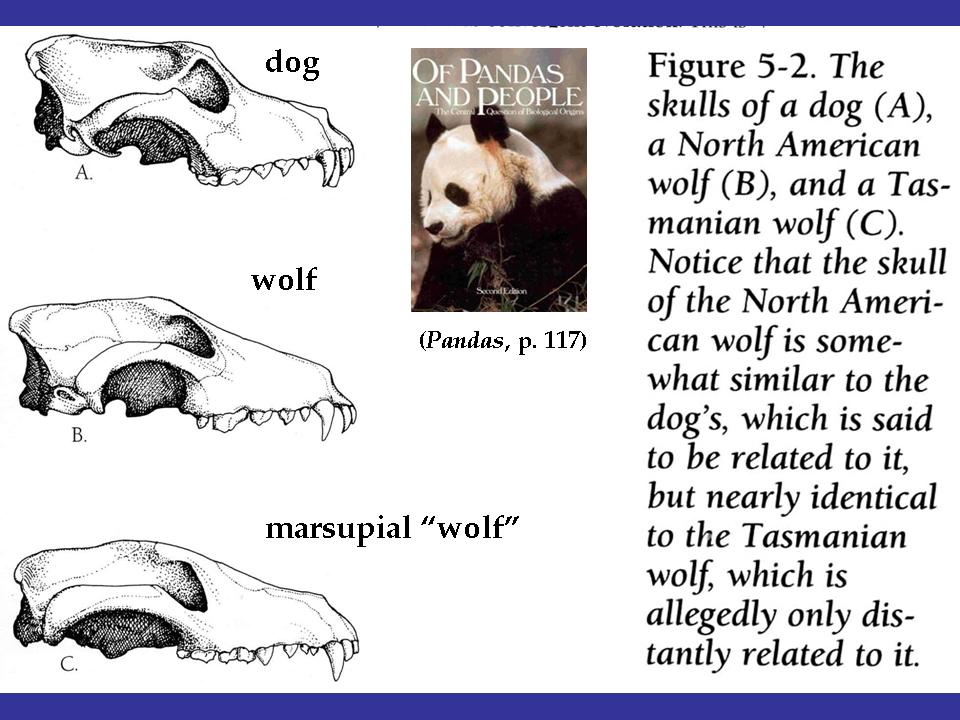 |
| Slide 84: Figure 5-2 of Pandas (p. 117) compares the skulls of a domestic dog (Canis lupus familiaris, a wolf (Canis lupus) and the marsupial "wolf" (also known as the Tasmanian wolf/Tasmanian tiger, or thylacine; scientific name: Thylacinus cynocephalus), a dog-sized marsupial carnivore. The standard evolutionary phylogeny says that the thylacine is more closely related to a kangaroo than a dog, and dogs and wolves are more closely related to humans and other placental mammals (whales, bats, etc.) than to any marsupial. Pandas says this relationship is doubtful and arbitrarily determined, claiming that the skulls of thylacines and wolves are more similar to each other than to their allegedly marsupial and placental relatives. |
| (Right-click to download pdf.) |
| Credits: Dog/wolf/thylacine skulls modified from Pandas Figure 5-2, p. 117. ©1993 by Foundation for Thought and Ethics, Richardson, TX 75083-0721 |
Pandas on homology: the real wolf and Tasmanian "wolf"
Q. And what does Pandas do with homology?
A. It's really weird. If I can give you an example, this one here comes from their figure 5-2. This is their drawing of a dog, a wolf, and an animal called the Tasmanian wolf, which is considered by all scientists to be a marsupial and not a placental mammal. Marsupial are animals like possums and kangaroos and phalangers and koalas and wombats that are a quite a different branch from the placental mammals, humans, primates, bats, wolves, things like that.
The caption here seems to make very little of the similarity between the dog and the wolf and a lot of the supposed identity between the Tasmanian wolf on the bottom, which they say in the caption is allegedly only distantly related to it. If I could have the next slide, this is what they're talking about in making these comparisons.
Q. And now this is from page 29 of Pandas?
A. It is. It says, "Despite these close parallels, because the two animals, that is the Tasmanian wolf and the conventional wolf, differ in a few features, the standard approach is to classify them in widely different categories." So the wolf with the dog and Tasmanian wolf with the kangaroo as a marsupial. Okay, and they're saying if similarity is the basis for classification, what do we do when these similarities conflict?
The marsupial wolf is strikingly similar to the placental wolf in most features. Yet it's like the kangaroo in one significant feature, by which they mean the pouch. Upon which similarity do we build our classification scheme? Should we use the pouch or should we use everything else they're saying. So in other words, they're trying to say that the resemblances between the wolf and the dog are simply superficial, and that just because those other marsupials have pouches doesn't mean we should always classify them together.
I don't think there's ever been any doubt about this since marsupials were discovered. I don't think that there has been mass confusion about marsupials versus placentals. But the next slide I think I would, if I may I would like to show you how a morphologist would look at this question.
Q. I'm sorry, are those these photos taken from Pandas?
A. No. These are photos taken from literature.
Q. And are these reasonable depictions of what these animals look like?
|
|
A. Yes. I think as mug shots they're okay. The Tasmanian wolf, the last one died in a zoo in the 1930's. I don't think we know of any living population since then. The dogs and the North American wolf of course are still around. The Tasmanian wolf is a very strange animal. You can see its stripes, its funny ears, its snout and so forth, but superficial similarities as we have seen are not the basis on which we establish science. Let's take a look at next set of slides. What we've done here is to take actual skulls from our museum. Here's a dog and a wolf.
Q. And this is how scientists, real scientists would make these comparisons?
|
|
A. Oh, yeah, and in each case we have taken features of the jaws and teeth just to show you the comparability among them. I don't need to run through all the features. I just want you to take a look and see that on this slide the no's and the yes's and the numbers line up pretty well between the dog and the wolf. Do you want me to go through the similarities? Okay, it's close enough for government work.
Then the next one here is the North American wolf and the so-called Tasmanian wolf, and in these features again every one of them is opposite, where you get no's, you get yes's, the numbers are wrong, and the carnassial tooth we see in the wolf above is missing in the Tasmanian wolf. So in these features they're completely different.
Let's go to the next slide, just looking at it the front way, which was not shown in Pandas, but the dog and the wolf, just to show that they both have nasal bones that are narrow or pinched in shape, with three incisors. The next slide contrasts the wolf with the Tasmanian wolf. The Tasmanian wolf has wide nasals and it has four incisors, which you wouldn't see from the side shot that the Pandas authors showed.
|
|
The next slide shows you a few of these skulls from underneath. The Tasmanian wolf has holes in the roof of its mouth, or palatal holes, which are lacked by the dog and the North American wolf. And the next slide shows the jawbones of these animals which have an opposite number of molars and premolar teeth between the Tasmanian wolf, and the dog and wolf.
|
|
Also you'll see that Tasmanian wolf has a couple of structures at the back of the jaw which we call the reflected lamina. The term is not important, but it's just a significant feature that's not present in the dog and the wolf. Well, let's do our next comparison and look at the Tasmanian wolf as it relates to the kangaroo, which we know is a marsupial.
In all the features that we've been looking at so far the kangaroo and the Tasmanian wolf correspond exactly with one exception, which is that the kangaroo doesn't have three premolars, and it doesn't have three premolars because the front of its face is modified in a way that many plant eating animals are modified. They lose those front cheek teeth and they developed the very most front teeth in the skull into a cropping organism that they use to, a cropping organ that they use to crop grass and other plants. Except for that, the features of the two skulls correspond. The next one, if you like that here's the Tasmanian wolf against the possum, and although --
|
| ||||||||
|
|
Q. That's another marsupial?
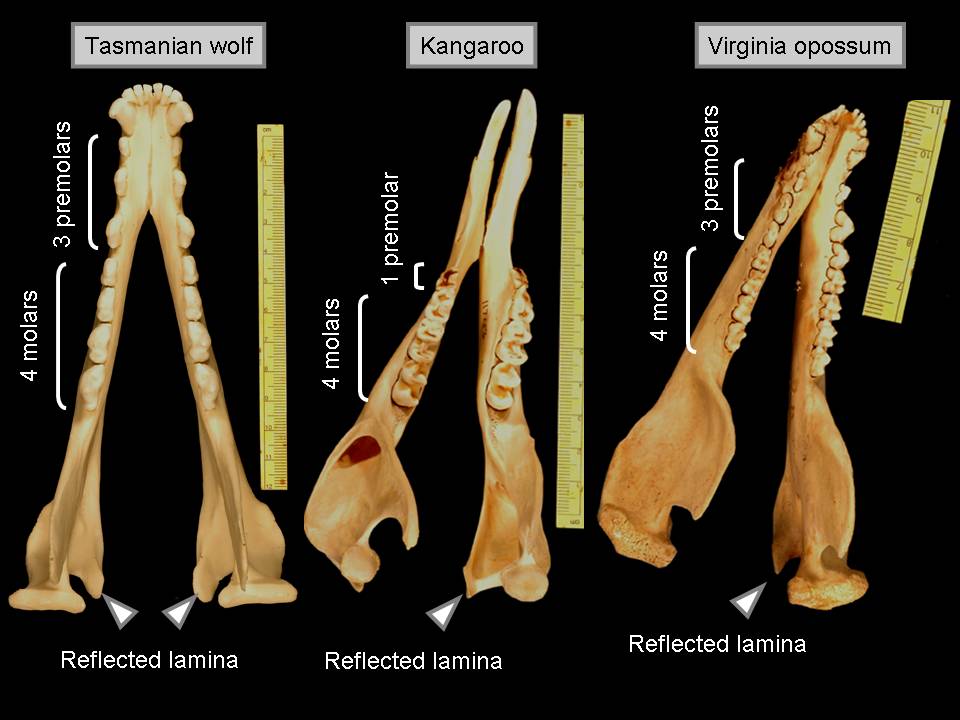 |
| Slide 97: All three marsupials share four molars and reflected laminae. |
| (Right-click to download pdf.) |
| Credits: Photos by Andrew Lee, U.C. Berkeley. Skulls from the U.C. Museum of Paleontology and the Museum of Vertebrate Zoology. Reproduced with permission. |
A. Another marsupial, yeah, our garden variety possum here, and although we saw that the kangaroo didn't have those first three premolars in front, the possum does. And the possum corresponds in all respects to those features in the Tasmanian wolf. Let's go a little bit further and look at then from the front. In each case all three, the kangaroo, the possum, and the Tasmanian wolf, have wide nasals. They have a different number of incisors, but they don't have three, except the kangaroo, which has very strange front incisors.
The next slide shows these three marsupials from the bottom. So I can just go back one, thank you. Shows these three skulls from the bottom. You can see that they all have palatal holes, holes in the roof of the mouth, which the dog and the wolf don't have. And the next slide I believe shows the jaws of these three animals, which everyone classifies as marsupials, which all have four molars, three premolars, except the kangaroo for reasons explained before, and they all have this reflected lamina in the back of the jaw.
So what are we to conclude from this? As the next slide shows -- oh, there are genetic similarities as well. I should mention that there have been several molecular studies that leave no doubt that marsupials are not just united by the pouch. They're even united by many molecular similarities that have nothing to do with the pouch as far as we can tell.
Q. Can you just read into the record the name of these articles and journals they're from?
A. Sure. One is from Molecular Phylogenetics and Evolution. Its title is, "Nuclear Gene Sequences Provide Evidence that a Monophyly of Australodelphian Marsupials" by which monophyly means that they all come from the same ancestors, the australodelphian marsupials means the guys that we know that are down there in Australia and some South American mammals.
Here's "An Analysis of Marsupial Interordinal Relationships," that means the relationships within the marsupials, "Based on 12S rRNA, tRNA Valine, 16S rRNA, and Cytochrome b Sequences." So here are four different molecules essentially, and this is in the Journal of Mammalian Evolution.
|
|
Here's a paper from the Royal Society of London on mitochondrial genomes. Again these are DN A that comes out of the mitochondria of cells, on a bandicoot, a brush tailed possum, confirm the monophyly of australodelphian marsupials once again.
Q. Are these just a representative sample of the peer reviewed literature that's out there?
A. Yes.
Q. So there's many more than this?
A. Yes.
Q. So --
A. I think the next slide might give us an indication that in summary it's not just the pouch. It's all these similarities here that link the Tasmanian wolf to the other marsupials and exclude them from the placentals, and that probably should be brought out to students. I believe the next slide gives us an indication of --
Q. Well, let me just stop you there. So from what you have just explained to us, this homology is used to kind of systematically compare animals?
A. Yes. It's a method as I said that goes back to the 1700's, looking for unusual similarities, listing all of them, putting them all together, and seeing which array of features makes the most sense.
Q. And is this widely accepted in science?
A. Yes. As I noted before, it's the basis by which we can do classification. Those shared features that we use for classification would not be anywhere if we didn't use the concept of homology.
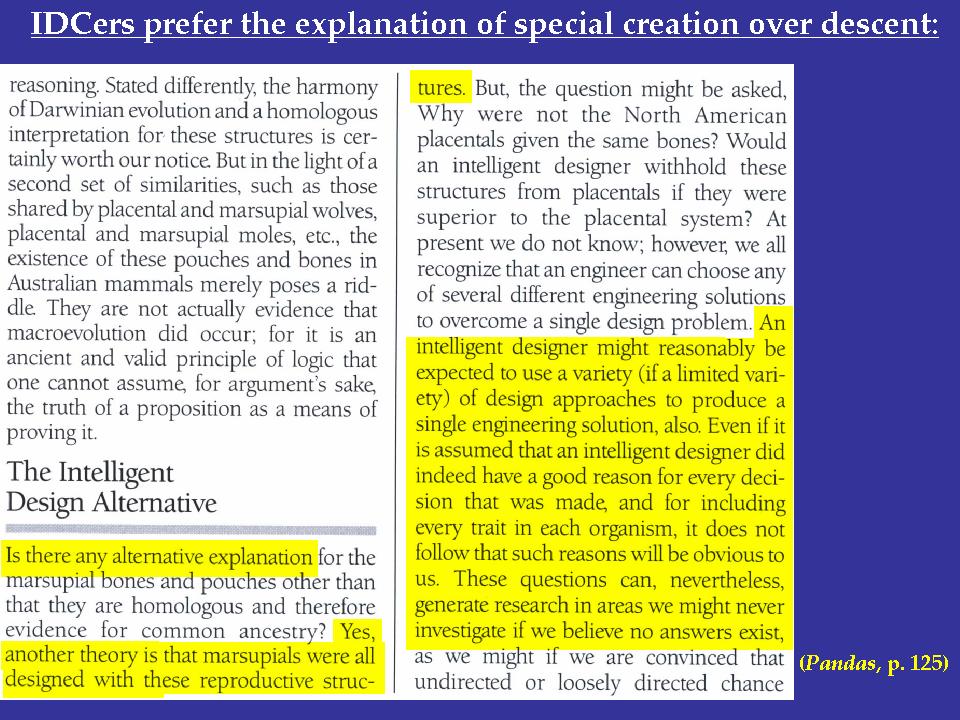 |
| Slide 100: Pandas (p. 125) argues against common ancestry because the authors clearly prefer special creation as an explanation for homology, even though they can answer none of the obvious questions raised by this notion. |
| (Right-click to download pdf.) |
IDCers prefer the explanation of special creation over descent
Q. And as we saw, Pandas seems to suggest that the classification and comparisons are arbitrary. How does Pandas use this misrepresentation of homology?
A. I think the next slide might give some indication of that. It seems quite clear from their text that they prefer the explanation of special creation over descent. The highlighted passages here from page 125 of Pandas ask if there is any alternative explanation. They say yes, another theory is that marsupials were all designed with these reproductive structures.
An intelligent designer they say might reasonably be expected to use a variety, if a limited variety, of design approaches to produce a single engineering solution. They say that even if we assume that an intelligent designer had a good reason for all these decisions, it doesn't follow that such reasons will be obvious to us. That's a perplexing statement, because it means that even though we have not been able to find a convincing pattern, and even though we do not know what the overarching plan is, we can still conclude that something was designed and could not have evolved.
They go on to say that, "These questions can nevertheless generate research in areas we might never investigate." I think as a scientist I'd be very concerned about how you can generate research questions when you have closed off an empirical avenue of, a very conventional empirical avenue of investigation, which is that these similarities are the result of common ancestry and provide no program for analyzing what intelligent design is, what the nature of the designer is, what the rules of design are by that designer, and this is I think classically a science stopper, especially when you tell students that these ideas should be considered but then you forbid discussion, you forbid questions.
Q. Now, it says in there that intelligent design should generate research. Are you aware of a significant body of scientific research on intelligent design?
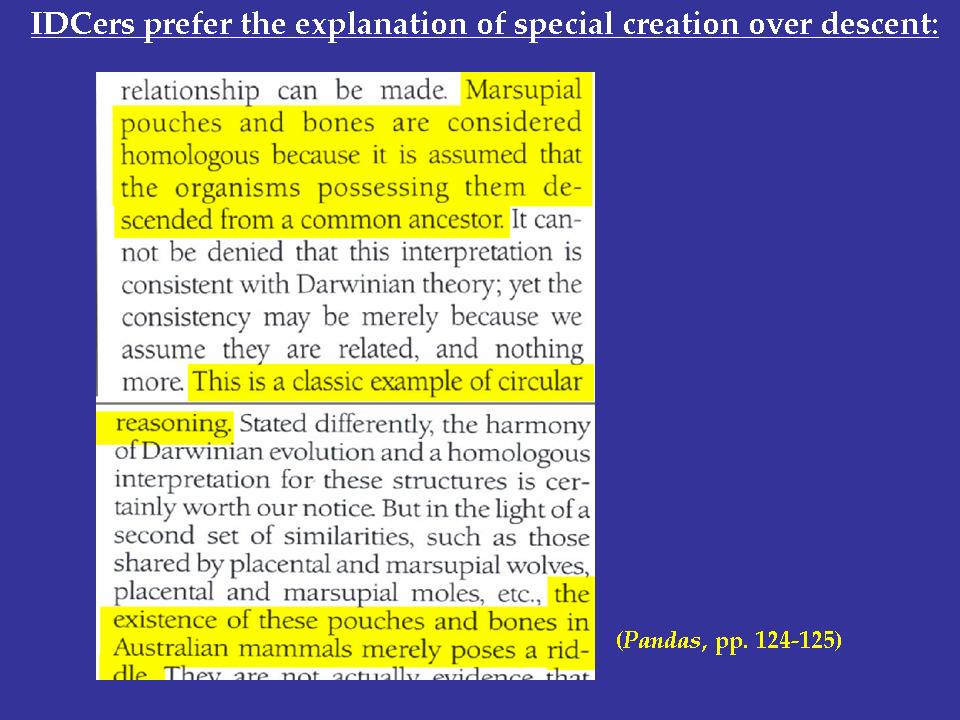 |
| Slide 101: Pandas claims that using homology to support common ancestry is circular reasoning, again ignoring that marsupial homologies extend far beyond just the pouch, and that DNA sequences have independently confirmed the longstanding conclusion of the morphologists. |
| (Right-click to download pdf.) |
A. Well, before I left I checked our electronic database in biology that's available through our library that surveys thousands of peer reviewed scientific journals, and I looked for intelligent design in the field of biology and all I could find were instances where humans had for example designed ergonomic chairs. And they wanted this to be intelligent design. Okay? But they didn't say anything about a creator or that these had evolved, and obviously we don't think chairs have evolved, we know that they are designed by humans.
Other instances referred to for example DN A splicing, where people are designing DNA if you will. They want to do it intelligently. Things like that, but I never saw a single instance where intelligent design had been used as a research program or even as a scientific concept. And similar studies made by other people have I believe turned up the same lack of stimulation of research in any scientific field.
Q. So we hear intelligent design proponents claim that some of their propositions are testable. How do you square that?
A. Well, they began by claiming that intelligent design should be considered on the same playing field with conventional science. They've had a couple of decades now to show that it should be. They don't seem terribly interested in producing reports, peer reviewed literature that will actually document that and change the scientific paradigm. So I'm not really sure what efforts they're trying to make to change the science.
Q. I guess what I'm asking about is that intelligent design makes claims that are testable, and those are claims that they have made about evolution.
A. I don't think any scientific society that's weighed in on this has accepted intelligent design as testable. Speaking for myself, I don't regard intelligent design as a testable idea scientifically. I regard it as a proposition of things that can't be tested scientifically but you recourse to when scientific explanations have failed. Parts of the things that are alleged to make up intelligent design or that are associated with it, such as irreducible complexity, may be a testable proposition, but let's take a look at that.
Irreducible complexity on its face is a simple statement about a machine or some kind of structure that has several parts. If you take away one of those parts, then it stops functioning. Well, any 8-year-old with a broken bicycle chain knows that he can't ride around anymore with a broken bicycle chain, if that part is broken it's not going to work. No one's got a Nobel prize for that proposition. This only makes sense in the context of intelligent design when irreducible complexity is invoked as a way to assert that no structure could have evolved by natural means.
Therefore, it is irreducibly complex. And as we've seen in cases where works like Pandas have asserted this, we've often found that there is evidence to the contrary that we can produce transitional sequences of things, or that the intelligent design advocates have simply left out a lot of the information probably because they do not accept it.
Q. So an essential component of the intelligent design argument is that evolution doesn't work?
A. That's correct.
Q. And they've given a number of examples involving the fossil record, involving your fields of expertise, whether it's no pre-Cambrian ancestors or the inability of fish to have evolved or birds to have evolved or we saw whales to have evolved, and in fact what has science done with all of the scientific predictions or those assertions where evolution doesn't work or that Pandas comes --
A. Well, they've been tested by the discovery of new evidence such as fossils, such as molecular evidence, such as new evidence in developmental biology, and in a great many cases we found that the proceeding difficulties or absences of evidence have disappeared. It's an important principle in philosophy that absence of evidence is not evidence of absence.
Q. But in fact the examples that Pandas has given to show that in fact evolution doesn't work have been refuted by the scientific community?
A. I believe that would be the interpretation of the scientific community, yes.
Q. And in fact the examples that Pandas has selected are only a very few of far more evidence that's out there supporting evolution?
A. Yes.
Q. And they haven't attacked those other bits of evidence?
A. No.
Q. But even those few bits of evidence that they have selected to argue that evolution doesn't work have largely been invalidated by empirical studies?
A. In many cases we would say that we've got a much better resolution to this. I certainly don't want to present we've solved every problem. Otherwise I'd have to go home and retire.
Q. We are going to try to get you home this weekend. Turn to the last slide we have here. Would you say intelligent design is a scientific proposition?
A. I don't think there's anything scientific about intelligent design. As I say, I think it's a sort of idea that you recur to when your scientific explanations fail.
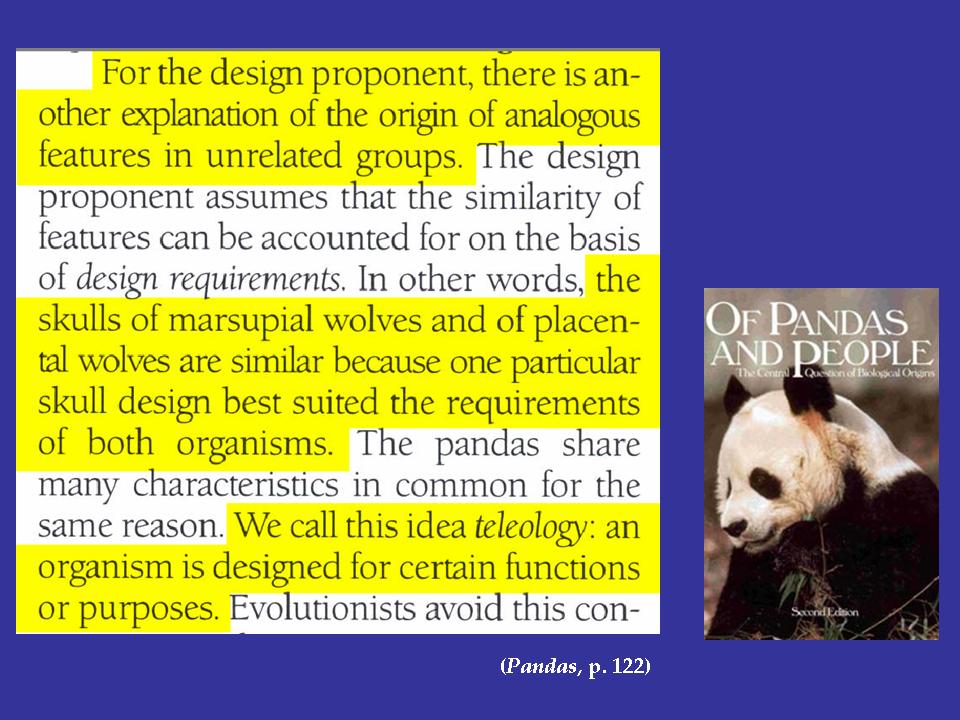 |
| Slide 102: Pandas invokes teleology as the explanation the authors prefer, clearly signaling what they are after. |
| (Right-click to download pdf.) |
Q. Do you think it's a religious proposition? And I direct your attention to page 122 of Pandas, and perhaps if you can read this passage into the record.
A. Well, this concerns me. They say, "For the design proponent, there is another explanation of the origin of analogous features and unrelated groups." They say, "For example, the skulls of marsupial wolves and of placental wolves are similar because one particular skull best suited the requirements of both organisms." We call this idea teleology. That is, they define this as organism that's designed for certain functions or purposes.
Now, when they say an organism is designed, that's maybe a statement, a static statement, it may be in the passive voice, but did someone design it. Again and again in Pandas they say that an intelligent designer has designed this for certain functions or purposes. This indeed is teleology, that things are there for, created for a certain end or purpose, and this is a philosophical and overtly religious notion that is absent from ideas of evolutionary biology.
Q. So teleology is not a scientific term?
A. No, not in the sense they're using it at all.
Q. Dr. Padian, you are familiar with the four-paragraph statement that the Dover school district is reading to students?
A. I've read it before.
Q. I'm not going to ask you to critique it paragraph by paragraph, other witnesses have done that. Let me just ask you, the Dover school district's response has been it's a one-minute statement, students don't have to stay in the classroom to listen to it, you know, what's the big deal? Why are we fighting this? Why are students harmed? Why is anybody harmed by reading this one-minute statement to the students?
A. Well, in my view, having educated students for thirty years, and so at a variety of levels from middle school up to graduate students my sense is that it's very difficult to constrain inquiry just by saying you're going to cut it off, and it's very difficult to say that if you just read a statement it's not going to harm anybody. It's quite clear from the evidence that's been given and from the fact that we're sitting here and by the situation that's developed in Dover, clear from news reports of people arguing with each other, parents arguing with other parents and teachers, teachers arguing with the school board, school board members arguing with each other and quitting, who knows how many bitter conversations have taken place in supermarket aisles and across telephone wires.
MR. MUISE: I'm going to object, Your Honor. This is going far down the road of speculation.
THE COURT: I'll overrule the objection to the extent that I'm not hearing anything that I haven't heard before, but why don't you interject a question at this point.
Q. So as a science educator, as somebody who has educated students for thirty years, why is this statement a problem?
A. It's clearly caused a great division in students, a great confusion. If some students are allowed to -- well, if students are required or allowed to hear a statement that is not read by their teacher, and unlike any other statement in the curriculum they may not ask questions about this and they may not discuss it further, this roping off of this kind of a statement means that it's to be treated differently.
It essentially ostracizes this area of study. It makes students confused, and they do ask questions. My students ask me questions about this kind of thing all the time. I don't think you can say that by cutting off inquiry you're going to stop people from asking questions. There are questions that intelligent design raises for students, and not just about science.
They are going to ask about if we have a situation where certain structures cannot evolve, that the natural processes that were perhaps created by a creator aren't sufficient to accomplish things, then what does this say about the perfection of the creation or the creator? What does this say about the ability of the creator to intervene in natural processes? If the creator can intervene, why doesn't he do so more often to relieve pain and suffering? And if this is a problem, of what good is prayer?
These concern me as someone who educates students in the science realm because they're not just asking questions about science. And if we close off inquiry to students and say that something cannot be anymore discussed in science, just accept it this way, or if we make religious propositions part of the science curriculum, then you cannot prevent them from being scrutinized in ways that are completely inappropriate in my view, in the purview of natural science, which never claims to answer such kinds of questions.
Q. And from your perspective as a scientist, what's the problem with this one-minute statement?
A. I think it makes people stupid. I think essentially it makes them ignorant. It confuses them unnecessarily about things that are well understood in science, about which there is no controversy, about ideas that have existed since the 1700's, about a broad body of scientific knowledge that's been developed over centuries by people with religious backgrounds and all walks of life, from all countries and faiths, on which everyone can understand.
I can do paleontology with people in Morocco, in Zimbabwe, in South Africa, in China, in India, any place around the world. I have co-authors in many countries around the world. We don't all share the same religious faith. We don't share the same philosophical outlook, but one thing is clear, and that is when we sit down at the table and do science, we put the rest of the stuff behind.
MR. ROTHSCHILD: I have no further questions.
THE COURT: Why don't we get started, we've only been at it about an hour. So we can get started with your cross, and then we'll take a break.
MR. MUISE: Thank you, Your Honor.
THE COURT: Why don't we try to break, Mr. Muise, in about fifteen minutes or so. That'll give you some time to get started.

